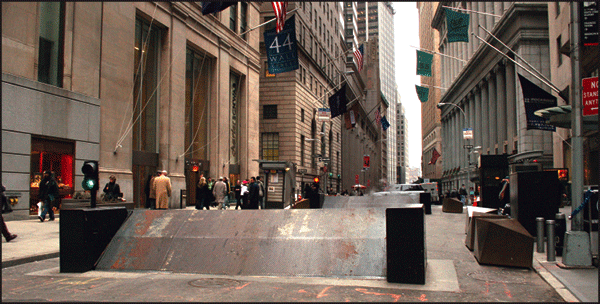By Julie Shapiro
After 9/11, aesthetics were the last thing on anyone’s mind. The city blocked off Lower Manhattan streets to car traffic, without worrying about the visual effect.
The gray metal barriers that secured Wall and Broad Sts. served their function — keeping potential terrorist targets safe — but they marred the historic streetscapes. By 2003, it was time for a change, and the city Economic Development Corporation, partnered with Rogers Marvel Architects, launched a streetscape revitalization project. They replaced some of the metal gates with bronze bollards and added street furniture to the newly pedestrian-friendly corridors.
Last week, Rogers Marvel Architects presented designs for Phase 2 of the project, which will finish the job, making the streets more visually appealing while blocking unwanted vehicles.
Rob Rogers, principal at Rogers Marvel, had no qualms about admitting mistakes on Broad St., known for the obtrusive gray metal barriers installed in double layers after 9/11.
“Those barricades are pretty gruesome,” Rogers said, as members of the Community Board 1 Financial District Committee agreed. “This is a blunder and we’re going to try and clean it up.”
Since cars sometimes need to travel on Broad St., permanent bronze bollards like those on Wall St. would not work. Using recent technology, Rogers Marvel found a solution: a turntable vehicle barrier. The circular turntable, embedded in the street, holds bollards that block traffic from entering Broad St. But when the turntable rotates 90 degrees, all the bollards line up, leaving a wide path for the occasional cars.
Several of the designs Rogers presented had a historic focus, and he often departed from architecture to give glimpses into Lower Manhattan’s history.
Wall St., for example, was named for a wall that ran down its center in the 1600s, marking the northern boundary of the Dutch New Amsterdam. The wall, made of wood, stood for about 50 years.
When redesigning Wall St., Rogers wanted to add the “concept” of the wall. Square wooden blocks, with a tightly spiraling grain, will be embedded in the street at intervals along Wall St., marking the path of the former wall. The blocks, flush with the pavement, will not obstruct views down Wall St. to the East River as a real wall would.
“We tried to keep it as visually porous as possible,” Rogers said.
Rogers also has plans for Broad St. between Beaver and Pine Sts., which still looks very much like it did following 9/11. As with Wall St., the architects looked to Broad St.’s history, in this case as a canal.
“We want to bring back an interpretive reference,” Rogers said, “and inlay with stonework the mark of the canal on Broad St.” Darker gray stones, much like those lining the Canyon of Heroes on Broadway, will mark the boundaries of the canal, which will not be raised from the street’s surface.
South of Exchange Pl. on Broad St., Rogers discovered one of the sunniest blocks in Lower Manhattan, especially at lunchtime. For 120 years, until the 1920s, that block hosted a “curb market,” where brokers traded stocks in new industries. To bring people back outdoors, Rogers will extend the sidewalk well into the street, creating a patio with outdoor furniture for workers and visitors.
The new curb, running down the middle of the street, will follow the path of the canal markers. Embedded along the edge of the canal, lines of text will describe the street’s history.
In the summer, the enlarged sidewalk on Broad St. could house a greenmarket or art installation, Rogers said. The Downtown Alliance, which is providing some of the street furniture, will make programming decisions.
The city economic development office refused to release the renderings shown to the community board.
Rogers Marvel is getting final approvals for the project and construction drawings are underway. Work should start in the late fall and will last 12 to 18 months, said Aaron Young, project architect. The construction manager is Bovis Lend Lease, the team in charge of the Deutsche Bank demolition and the Trump Soho condo-hotel, both of which have seen fatalities within the last year.
C.B. 1 members sounded less than happy to hear Bovis’s name mentioned, but the overall plan received rave reviews.
“What’s not to like about this plan?” said Ro Sheffe, chairperson of the Financial District Committee. “I like the historical aspect of it.”
As the lights came back on, Catherine McVay Hughes had one word for the architects: “gorgeous,” she said.
Julie@DowntownExpress.com



























